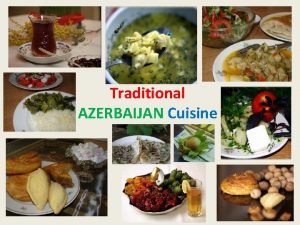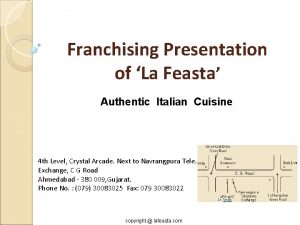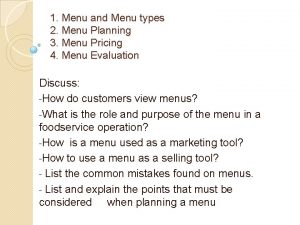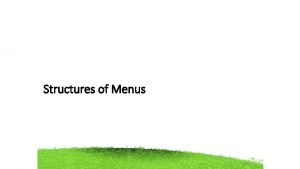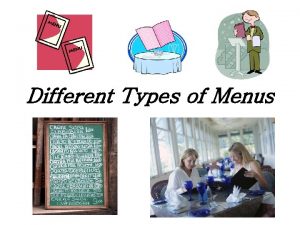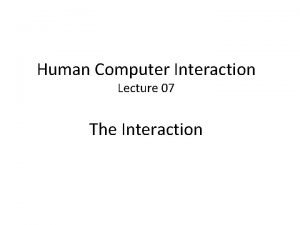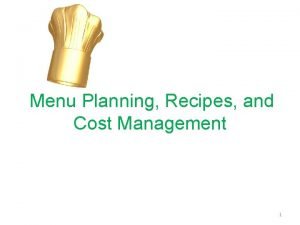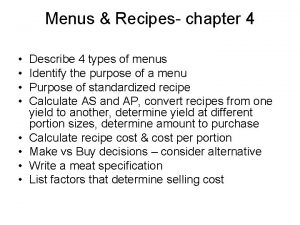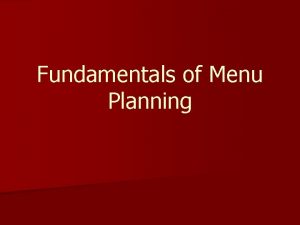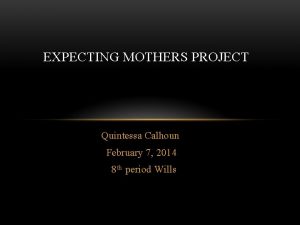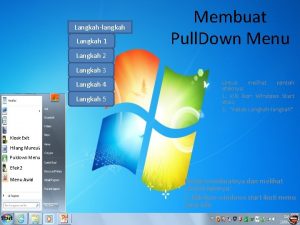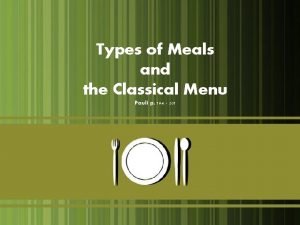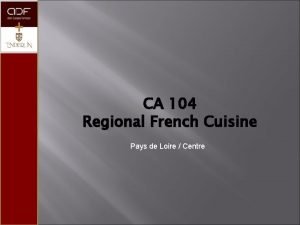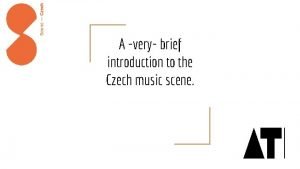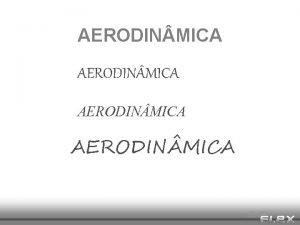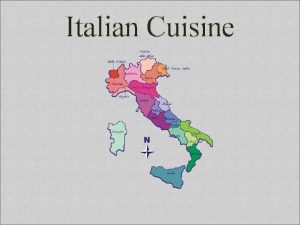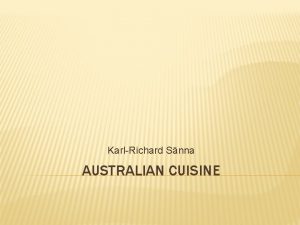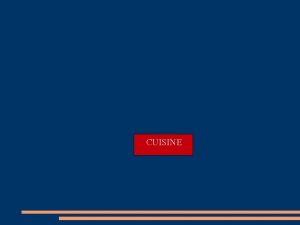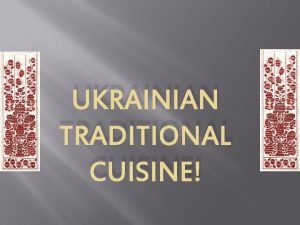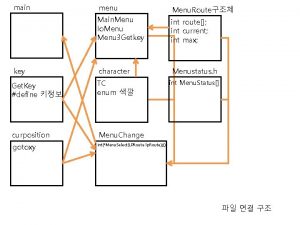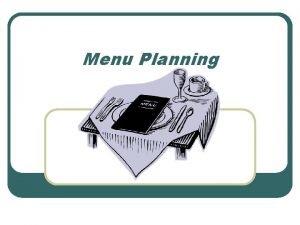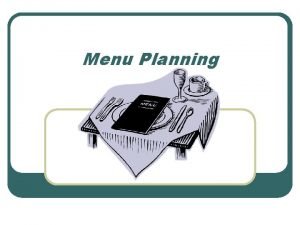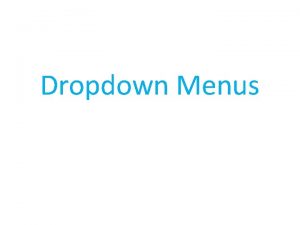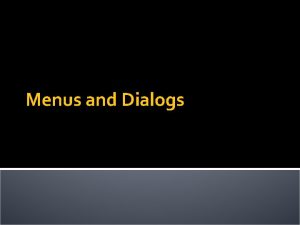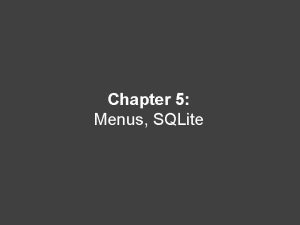Italian Cuisine 1 Italian Menu Traditional Italian menus






























- Slides: 30

Italian Cuisine 1

Italian Menu • Traditional Italian menus normally have the following five sections: • 1. Antipasti (Appetizers): This is an appetizer course served quickly after you have ordered your meal. Popular antipasti items include bruschetta (grilled bread with olive oil, and garlic with a variety of toppings, caprese (basil and tomato slices on fresh mozzarella cheese) and a number of vegetarian items. 2

• 2. Primo (First Course): This is the soup or pasta course. It is not the main meal. In addition to soup and pasta, gnocchi or risotto dishes may be offered. • 3. Secondo (Second Course): This is the main dish, usually meat or fish. This course does not normally come with vegetables, as these are ordered separately in the Contorni section 3

• 4. Contorni (Side Dishes): These side dishes (served on separate plates as accompaniments to the secondo) consist of vegetables such as potatoes, eggplant, spinach, tomatoes, etc. 4

• 5. Dolci(Desserts): This is the "sweet" course but, in addition to sweets, fruit, cheese and nuts may also be offered. 5

• It is not necessary to order all of the above courses in an Italian meal, but you will normally be expected at most restaurants to order at least the Antipasti and either the Primo or Secondo courses. 6

• It is advisable to make reservations ahead of time for dinner. Reserving a table in a restaurant in Italy is seen as a gesture of respect for the owner, and will assure you a table. 7

• It is usually not necessary to make a reservation for lunch, however. When making a reservation for dinner, be aware that most Italians tend to dine out a little later (about 9: 00 p. m. ) than you may be used to in your home country - so don't ask for a reservation time too much earlier than this. 8

Dress • Italians dress with a casual elegance when they dine out. Most restaurants do not require a jacket or tie but frown on customers wearing blue jeans, T-shirts or running shoes. 9

Ordering Your Meal • It is considered bad practice in Italy to beckon or approach a waiter when you are ready to order. • Sit and wait a while at your table and the waiter will approach you when ready to take your order. 10

• Order your wine first and then order your meal, section by section of the menu. • First order your antipasti, then the primo, secondo and contorni. • Do not order dessert until you have finished your meal. 11

• Note that each course of an Italian meal is served separately. • The dishes are not brought to the table at once. • There will be a wait between the antipasto and the primo course. 12

• The primo arrives for all people at the same time. • There will be another wait between the primo course and the secondo course. • When the secondo arrives, your contorno (side dishes) also arrive 13

• Normally, coffee is served after you have finished your meal, never with it. • Order coffee after the dessert course as coffee and dessert is not normally served at the same time. 14

Paying the Restaurant Bill • The waiter will not give you the bill for your meal until you request it. • The bill will normally include a cover charge (pane e coperto). • This charge is usually listed on the menu. 15

• In addition, some restaurants will add a service charge. • This charge will ordinarily be listed on the menu (e. g. "Servizio 10%"). • If there is a service charge, tipping the waiter is not necessary unless you wish to do so. • If no service applies, a tip of about 10% is expected. 16

How To Impress Italian Waiters • Here's How: • If you see food on display as you enter the restaurant, walk over to it and eye it thoughtfully. • When the waiter arrives to see what you're up to, discuss the quality of the food displayed, looking into anything that resembles an eye, especially if it's part of a fish. 17

• Once you arrive at your table, order the house wine. Your choices are red and white. Avoid anything fancy. • After the waiter brings the wine, you may, if so inclined, order antipaste. 18

• If you've declined antipaste, you may order a primo. This is soup or pasta. No, it's not the whole meal, it's just a little hi-carb teaser before the meat. • After the pasta you may order a slab of meat or one of the fish whose eyes you've already checked out. 19

• Along with the meat, you'll need a contorno, a contour. This is a vegetable or salad that will ease you into dessert. • Then there's dolce, sweets. This isn't really a very important part of an Italian meal so order some biscotti, a hard cookie that goes will with Italian coffee (espresso). 20

• Cafe is a must with the biscotti. To appear Italian, you'll need to fill the little espresso cup with at least 4 tablespoons of sugar. Do not order a latte, that just means milk. • After the meal you'll want to slump in your chair as if you've had a heart attack. This will alert the waiter to the fact you've had more than enough. 21

Tips • Nothing will make you sound more like an ignorant American than forgetting to pronounce the vowels at the end of an Italian word. 22

• You might want to try cafe corretto at the end of your meal. • That's "corrected coffee" with a dribble of booze in it, frequently Sambuca or grappa. • In Italy, you might drink this for your midmorning picker-upper. 23

• Never, use a spoon to twirl the pasta. In Italy, spoons are given to children to assist them with their yet-to-develop coordination. 24

Cannoli • It was once a carnival dessert, the "scepter of the Carnival King, " but it is now consumed throughout the year. The cannoli are made by stuffing cylinders of fried dough with sheep’s milk ricotta flavored with sugar, pieces of candied fruit and bits of chocolate. 25

Biscotti • There is an infinity of biscuits with a vast range of flavors and forms. Most of the biscuits are associated with religious holidays. • The biscuits of Santa Lucia are shaped like eyes, while the ossa di morti (bones of the dead) are strongly scented with cloves. 26

Spaghetti 27

Pasta Primavera 28

Chicken Lasagna Rolls with Red Pepper Sauce 29

Chicken Fettuccine with Pepper Cream Sauce 30
 Traditional azerbaijani cuisine
Traditional azerbaijani cuisine Italian cuisine presentation
Italian cuisine presentation Club 601
Club 601 Palettes and tear-off menus
Palettes and tear-off menus What is a cyclical menu?
What is a cyclical menu? Types of menu
Types of menu Cacfp menu
Cacfp menu Fiesta americana puerto vallarta restaurant menus
Fiesta americana puerto vallarta restaurant menus Explain factors to consider when proposing dishes for menus
Explain factors to consider when proposing dishes for menus Event trapping menus examples
Event trapping menus examples Linear sequences dan multiple menus
Linear sequences dan multiple menus The type of menu that offers the same dishes everyday
The type of menu that offers the same dishes everyday Wimp interface
Wimp interface Menus recipes and cost management
Menus recipes and cost management What are the four types of menus
What are the four types of menus Unitized group rations
Unitized group rations Palettes and tear-off menus
Palettes and tear-off menus Purpose of menu
Purpose of menu 5 days of sample menus for pregnant women
5 days of sample menus for pregnant women Bagian bagian browser
Bagian bagian browser Langkah-langkah perencanaan menu
Langkah-langkah perencanaan menu Menu pull down exit terdapat pada menu..
Menu pull down exit terdapat pada menu.. Fungsi menu page layout
Fungsi menu page layout Difference between classical menu and modern menu
Difference between classical menu and modern menu Nested quantifiers exercises
Nested quantifiers exercises Brigade de cuisine
Brigade de cuisine Chinese cuisine logo
Chinese cuisine logo Precious chinese cuisine
Precious chinese cuisine Pays de la loire food
Pays de la loire food Czech cuisine of perversions
Czech cuisine of perversions Carnet personnel de techniques professionnelles cap cuisine
Carnet personnel de techniques professionnelles cap cuisine
